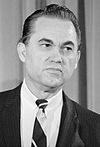Executive Order 11111
It has been suggested that this article be merged into Stand in the Schoolhouse Door. (Discuss) Proposed since May 2017. |

Executive Order 11111 is an executive order signed by President of the United States John F. Kennedy on 11 June 1963. It was signed to prevent the Governor of Alabama George Wallace preventing integration of schooling in Alabama.[1] The act also authorised the Secretary of Defense to federalize the Alabama National Guard.
History
On 11 June 1963, Governor Wallace stood in the door of Foster Auditorium of the University of Alabama in Tuscaloosa to prevent black students from registering for classes in what became known as the Stand in the Schoolhouse Door. President Kennedy had issued a presidential proclamation demanding that Wallace stepped aside but had the text of the future Executive Order 11111 prepared in case Wallace did not comply.[2] The Deputy Attorney General of the United States Nicholas Katzenbach telephoned President Kennedy and told him of Wallace's actions in ignoring the proclamation as it had no legal force.[3] In response, Kennedy issued Executive Order 11111 authorizing the federalization of the Alabama National Guard.[4] Four hours later, National Guard General Henry V. Graham announced the Executive Order to Wallace stating, "Sir, it is my sad duty to ask you to step aside under the orders of the President of the United States."[5] Wallace, recognizing what had happened, made a final speech denouncing violence and Kennedy's action[6] but eventually stepped aside.[5] Executive Order 11111 was also used to ensure that the Alabama National Guard made sure that black students across the state were able to enroll at previously all-white schools.[7]
In the days following the enactment, the National Guard were ordered to remain on the campus owing to a large Klu Klux Klan contingent in the surrounding area. Wallace and Kennedy exchanged volatile telegrams over it.[8] Wallace objected to Kennedy ordering the Guard to remain on the campus and said that Kennedy bore responsibility if something happened.[8] Kennedy responded stating that Executive Order 11111 made it clear that responsibility for keeping the peace remained with the state troopers under Wallace's control and said he would revoke the order if assurances were made.[8] Wallace refused stating he would not be intimidated citing that Executive Order 11111 was passed without his knowledge and made frequent references to Kennedy "usurping" his authority via the Order.[8]
Executive Order 11111, which as of 2017[update] has not been revoked, was complemented in September 1963 by Executive Order 11118.[1][9]
References
- ^ a b "Executive Orders Disposition Tables". National Archives. Retrieved 2017-05-11.
- ^ Willis, Jim (2015). 1960s Counterculture: Documents Decoded: Documents Decoded. ABC-CLIO. p. 82. ISBN 1610695232.
- ^ "Executive Order 10730: Little Rock Nine: Integration of the University of Alabama". Shmoop. Retrieved 2017-05-11.
- ^ "JFK faces down defiant governor - Jun 11, 1963". History Channel. Retrieved 2017-05-11.
- ^ a b Lesher, Stephan (1995). George Wallace: American Populist. Da Capo Press. p. 233. ISBN 9780201407983.
- ^ "Alabama Admits Negro Students; Wallace Bows to Federal Force; Kennedy Sees 'Moral Crisis' in U.S". New York Times. 1963-06-12. Retrieved 2017-05-11.
- ^ "Kennedy federalized National Guard to integrate Alabama public schools (Sept. 10, 1963)". AL.com. Retrieved 2017-05-11.
- ^ a b c d "Dueling Telegrams: 1963 verbal power play between Wallace and JFK" (PDF). Alabama State Archives. Retrieved 2017-05-11.
{{cite journal}}: Cite journal requires|journal=(help) - ^ United States General Accounting Office (1965). Decisions of the Comptroller General of the United States. Vol. 43. U.S. Government Printing Office. p. 296.
